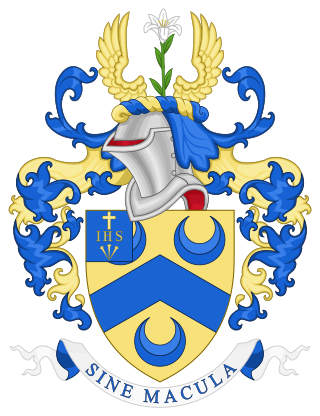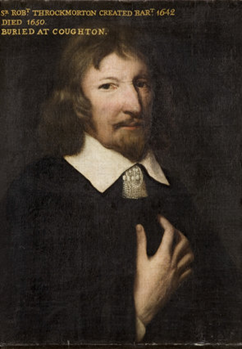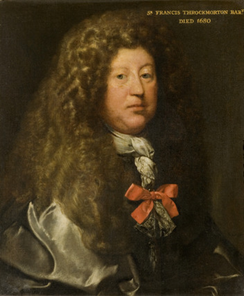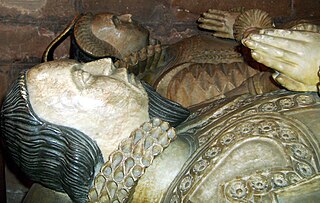
Robert Catesby was the leader of a group of English Catholics who planned the failed Gunpowder Plot of 1605.
Francis Tresham, eldest son of Thomas Tresham and Muriel Throckmorton, was a member of the group of English provincial Catholics who planned the failed Gunpowder Plot of 1605, a conspiracy to assassinate King James I of England.

Sir Thomas Tresham was a prominent recusant Catholic landowner in Elizabethan Northamptonshire. He died two years after the accession of James VI and I.

Mount St Mary's College is an independent, co-educational, day and boarding school situated at Spinkhill, Derbyshire, England. It was founded in 1842 by the Society of Jesus, and has buildings designed by notable architects such as Joseph Hansom, Henry Clutter and Adrian Gilbert Scott. The school is a member of the Headmasters' and Headmistresses' Conference and the Catholic Independent Schools Conference.

Coughton Court is an English Tudor country house, situated on the main road between Studley and Alcester in Warwickshire. It is a Grade I listed building.

There have been two baronetcies created for different branches of the Throckmorton family, 6th cousins, both descended from Sir John Throckmorton, Under-Treasurer of England temp. King Henry VI (1422–1461). Both titles, which were in the Baronetage of England, are now extinct. The Throckmortons, originally of Throckmorton near Pershore, Worcestershire, trace their history back to the 12th century. In 1409 Sir John de Throckmorton, Under-Treasurer of England, married Eleanor Spinney, daughter and heiress of Guy Spinney of Coughton, Warwickshire, where the senior branch of the family, which bore the junior baronetcy, became established. The Coughton estate included in 1968 a dower house named "Spiney House, Coughton", named after that family. The senior Throckmorton Baronetcy, of Tortworth in the County of Gloucester, was created in the Baronetage of England on 29 June 1611 for William Throckmorton, of Coss Court, Tortworth, Gloucestershire, sixth in descent from John Throckmorton, younger son of Sir John Throckmorton, Under-Treasurer of England. The third Baronet sat as Member of Parliament for Gloucestershire and Wotton Basset. The title became extinct on the death of the fourth Baronet in a duel in 1682.
Elizabeth Clare McLaren-Throckmorton, known professionally as Clare Tritton, QC, was a British barrister and descendant of the Throckmorton baronets. She was the tenant of the Throckmorton family's main residence, Coughton Court near Alcester in Warwickshire, England, now owned by the National Trust. She was also the owner of the Molland Estate in North Devon.

Sir George Throckmorton of Coughton Court in Warwickshire, England, was a Member of Parliament during the reign of King Henry VIII.

Harvington Hall is a moated medieval and Elizabethan manor house in the hamlet of Harvington in the civil parish of Chaddesley Corbett, southeast of Kidderminster in the English county of Worcestershire.

Sir Robert Throckmorton, KG, of Coughton Court in Warwickshire, was a Member of Parliament and a distinguished English courtier. His public career was impeded by remaining a Roman Catholic.

Sir Robert George Throckmorton, 8th Baronet was an English Whig and Liberal politician who sat in the House of Commons from 1831 to 1835.

Sir Robert Throckmorton, 1st Baronet (1599–1650) was created a baronet, of Coughton, co. Warwick, on 1 September 1642.

Sir Francis Throckmorton, 2nd Baronet (1641–1680), of Coughton Court, Warwickshire and Weston Underwood, Buckinghamshire, was a member of a prominent English family of Roman Catholic dissenters.

John Giffard (1534–1613) was a Staffordshire landowner and Member of the English Parliament, notable as a leader of Roman Catholic Recusancy in the reigns of Elizabeth I and James I.
Thomas Throckmorton was an English politician, a Member (MP) of the Parliament of England for Warwickshire in 1558 and Warwick in 1559. He spent much of his life undergoing fines and long periods of imprisonment for recusancy. He resided primarily at Weston Underwood, Buckinghamshire.

Anne Throckmorton or name in religion Anne Frances was an English poet who was prioress of the Convent of Our Blessed Lady of Syon in Paris from 1720 to 1728.

Sir Robert Throckmorton, 4th Baronet, was a member of a prominent English family of Roman Catholic dissenters.

Sir John Courtenay Throckmorton, 5th Baronet, was a member of a prominent English family of Roman Catholic dissenters and "its only published author of any significance."

Sir Charles Throckmorton, 7th Baronet, was a member of a prominent English family of Roman Catholic dissenters.

Sir Robert Throckmorton, 3rd Baronet, was a member of a prominent English family of Roman Catholic dissenters.


















